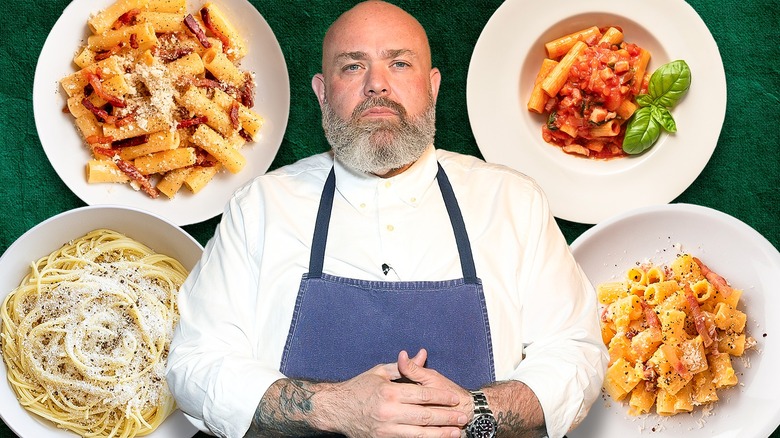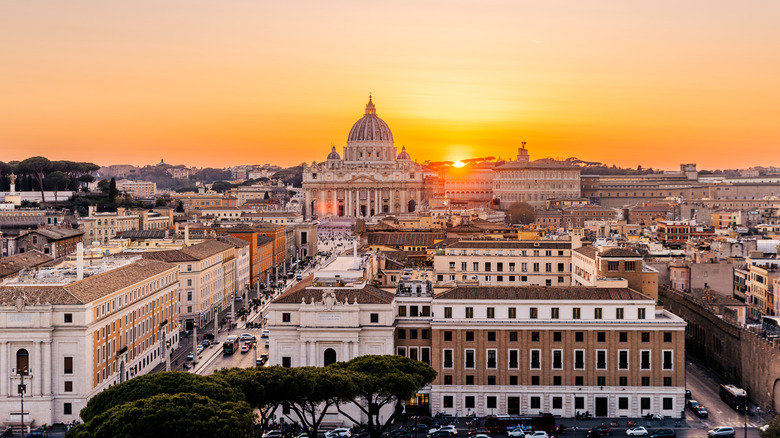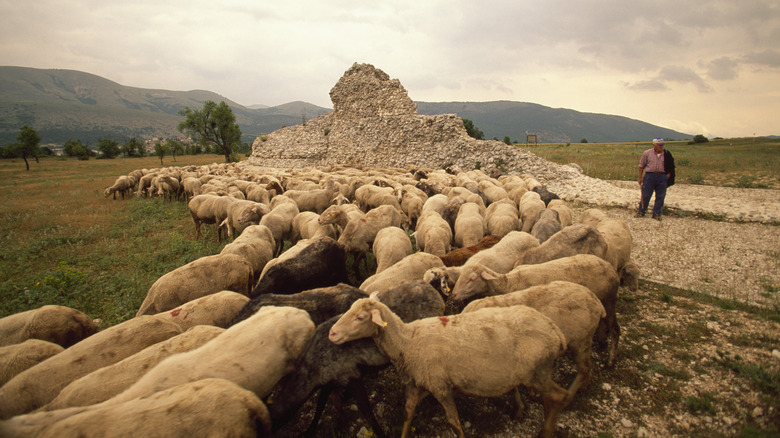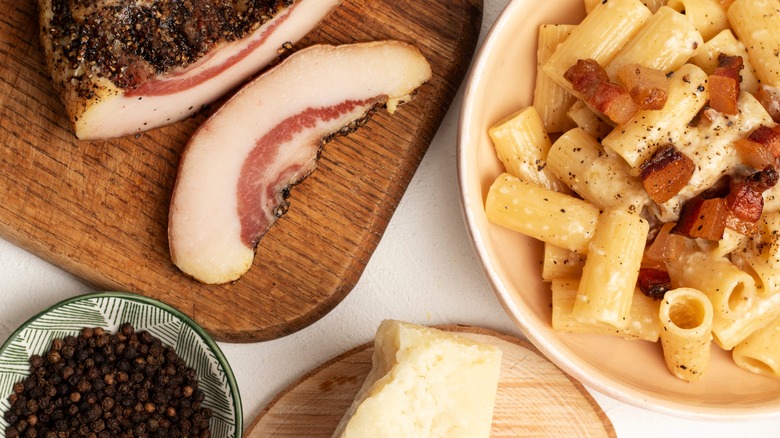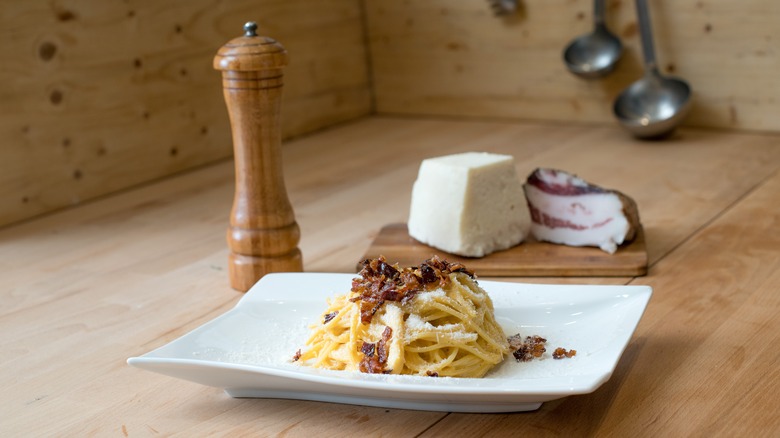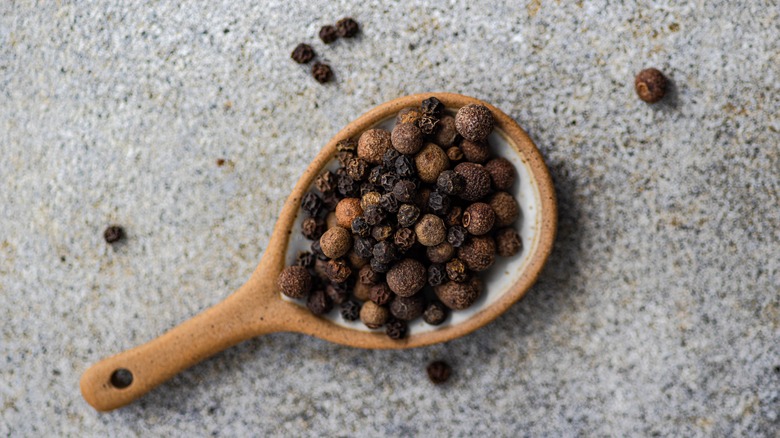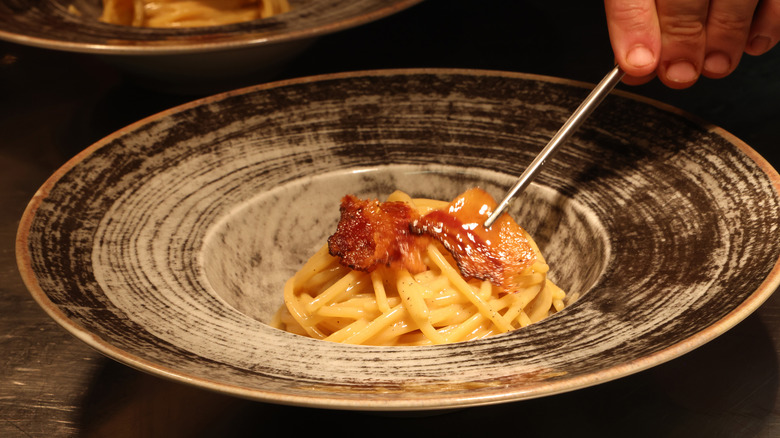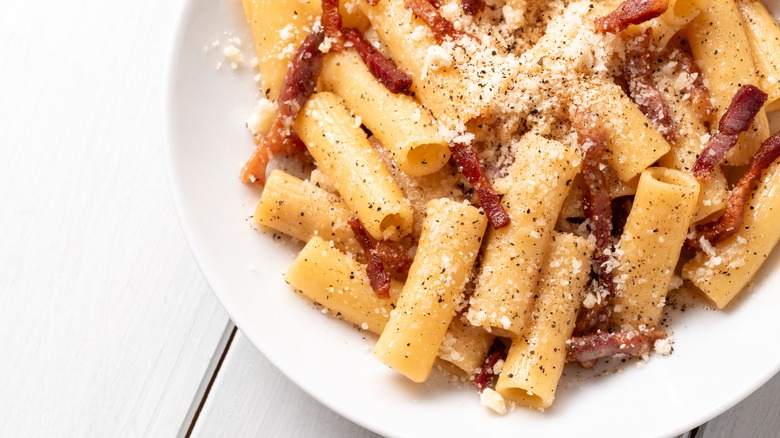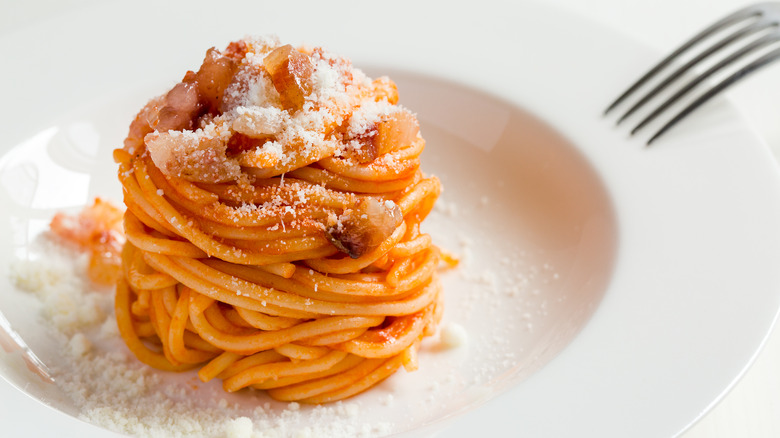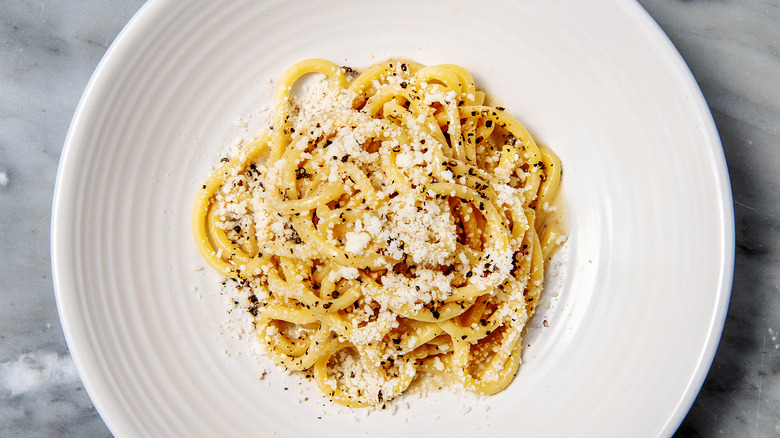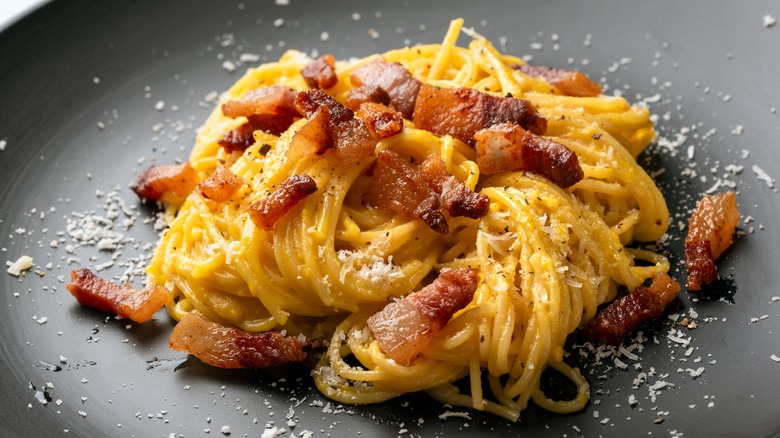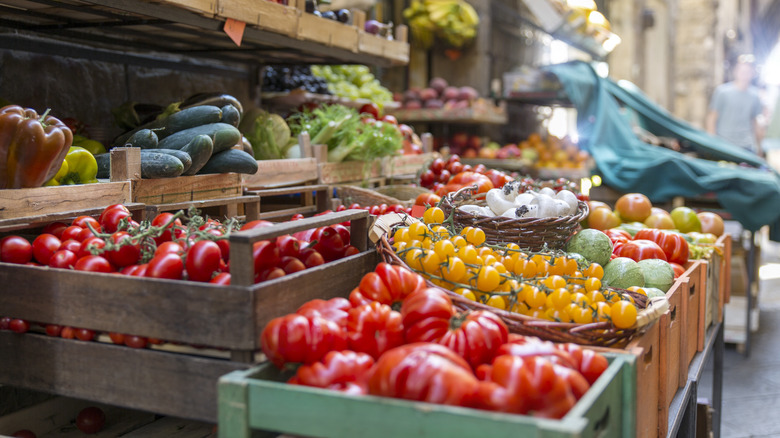Everything You Need To Know About Roman Pasta, According To Evan Funke
The eternal city of Rome is not just famous for its tremendous history and treasures of art. Traditional Roman cuisine, which overlaps with that of the region of Lazio and surrounding areas, is an integral part of the culture of Rome. Roman cuisine is vast and varied and uses thousands of ingredients, both fresh and preserved, and there is much more to Roman cuisine than just pasta. Nevertheless, four classic Roman pasta dishes take the spotlight and feature the same key ingredients — pasta alla gricia, pasta all'amatriciana, pasta cacio e pepe, and pasta alla carbonara. These are celebrated not only for their complex flavors and decadent, simple ingredients, but also for their links to ancient tradition, migratory patterns of people and sheep, and practicality.
We spoke with Chef Evan Funke, a master of Italian handmade pasta making. Funke is passionate about protecting old-world Italian culinary tradition, which he features in his six restaurants across the country. His Mother Wolf restaurants in Las Vegas, Los Angeles, and Miami specifically honor Roman cuisine. Funke is one of the acclaimed chefs in the series "Chef's Table: Noodles" on Netflix, which explores the art of noodle making and the stories behind the featured chefs' signature dishes. Funke shared his knowledge with us about the origins of Roman pasta and what makes it unique, and he offers tips on ingredients and how to make the delicious signature pasta dishes for which Rome is known throughout the world.
What makes Roman pasta unique?
Evan Funke shares his perspective on what sets pasta dishes from Rome apart: "I think that what makes Roman pasta unique is, it's almost somewhat dogmatic in its approach. It lends itself to consistency. Romans are very proud of their heritage, as are most Italian people and regions. The term for that is campanilismo, meaning pride of one's origin." However, Funke points out that Romans were also conquerors. Their interaction with other peoples and cultures from the central Italian regions of Lazio, Umbria, and Abruzzo, which are areas around Rome, made the city a melting pot of collected recipes, which Funke believes is a unique trait.
Funke says that Roman cuisine has historically been influenced by frequent travelers and passers-by who contributed to building a large foundation of dishes that are considered to be very Roman now. This history and these diverse contributions give added meaning to classic Roman fare, as Funke explains: "I think what's kind of beautiful about just Italian food, in general, and Roman dishes, specifically, is the wonderful storytelling that goes along with a majority of the dishes. Rome as a city is an extraordinary place. Some would argue the most important city in the world." He said the storytelling continues to this day, likening Rome to a living museum where ancient ruins and modern life coexist in harmony in a single place.
Roman pasta is linked to pastoral communities
The four most popular Roman pasta dishes, which Evan Funke calls the four horsemen, all feature cured meat and aged cheese, namely, guanciale and pecorino romano. While it's easy to think that Roman pasta is short on fresh produce, that's not true. The use of preserved ingredients makes sense when looking at these dishes from a historical and geographical perspective. They were ancient on-the-go foods tied to the important Italian custom of transhumance, which is the seasonal migration of sheep up into mountain pastures in warmer weather and down to lowland pastures in the fall.
Funke explains that most classic Roman dishes were created in Central Italian pastoral communities and thus were built for travel. It was difficult for shepherds traversing long distances with a flock of sheep to carry fresh vegetables, so they opted for ingredients with a long shelf life that could be carried by mule for several hundred miles. "So that's why you see dried pasta, pecorino romano that has been aged and made by the shepherds, aged with salt, and then a salt-cured pork product because it has longevity and shelf life," Funke says. "It comes from a place of poverty and the ability to be mobile. But there are literally thousands, everything from artichokes to kale, to wild greens, to herbs ... every vegetable you can possibly imagine that exists in the Mediterranean diet has ended up in a pasta dish at one time or another."
The right ingredients work magic
When asked if key ingredients for Roman pasta recipes can be found in the US, Evan Funke says that they can. He recommends shopping at Italian specialty stores to find high-quality ingredients. Guanciale can be found at most of these stores, he says. So can black pepper, pecorino romano from Rome or Parmigiano Reggiano, and dried pasta. He emphasizes buying whole pieces of cheese over pre-grated packages, and, if you're not making homemade pasta, choosing pasta from Gragnano if possible. His number one ingredient tip is not to oversalt the pasta water. He recommends 1% salt by weight.
While quality ingredients are important, Funke doesn't give them all the credit, especially if you're lucky enough to cook or eat in Italy: "Yes, the quality of the ingredients, ultimately, will dictate the success of anyone's dish if they're paying the right amount of attention and have the right intentions for the dish, and are being in service of those ingredients, basically trying not to mess them up," he says. "When people are in Italy, they kind of suspend their reality for a moment because they're in a magical place where bread and olive oil can be life-changing because when you're there, your mind is open to new experience that would, in regular life, seem completely benign ... and if you take those same ingredients in your apartment in New York City, and you take the same bread and the same olive oil, it lacks that magic."
Guanciale and pecorino romano are key ingredients
Guanciale, a cured meat that comes from pig's cheek (guancia means cheek or jowl in Italian), is a prized ingredient in Roman cuisine. It's a whitish, fatty cut of meat, with smaller amounts of lean meat forming darker red sections in the piece. Pancetta is different from guanciale because it contains more lean meat, which means you need to add oil to cook it, and it's aged less. Italian sources tend to warn against substituting pancetta in dishes that call for the fattier and stronger guanciale, but pancetta is a lot easier to find outside of Italy. When making pasta, cut cubes of guanciale about ⅜ inch long, because too-small cubes will dry out, and cook it in a heavy pan like cast iron to caramelize the meat and make it crispy.
Pecorino romano, a hard, aged sheep's milk cheese (pecora means sheep in Italian), is an integral ingredient in Roman cuisine. It's the type of cheese that's always used to make Roman dishes like cacio e pepe and pasta alla gricia. The taste of pecorino romano is strong, rustic, and salty, and the texture is grainy and dry, ideal for grating. For the best flavor, buy whole pieces as opposed to pre-grated packages. As a Protected Designation of Origin (PDO) cheese, it's only made in Italy using strict traditional standards and ingredients. Look for authentic pieces with the PDO label on the packaging (this will be written as DOP on Italian packaging).
Other important ingredients in Roman pasta
A few other key ingredients warrant special mention. Black pepper is one of the spices and herbs that was used during the Roman Empire to elevate the flavors of dishes after increased trading with Eastern states led to its wide availability. In the Middle Ages, black pepper became so expensive it was known as black gold because of tight control of its import by Genoan and Venetian traders, but it was more commonly consumed in Roman times. And it still is today.
You'll get the best flavor and texture if you start with whole black peppercorns and crush them yourself in a mortar and pestle right before use. Evan Funke shares additional advice: "The best, I think, tip I can give home cooks is to toast your black pepper first in a dry pan that's been over medium heat for a few moments. Toast the black pepper, freshly cracked, until you bring the natural oils to the surface of the black pepper, and then add a little bit of fat to that so that the oils infuse together."
Good eggs are also key, especially in dishes like carbonara that require raw eggs. Funke recommends "finding very high-quality eggs. I eat raw eggs all the time, high-quality eggs from the farmer's market. If you can't find them, look for high-quality farm-raised, free-range organic eggs." Finally, consider splurging for bronze-cut pasta over regular industrial pasta if you can. The difference in texture and taste is noticeable.
Roman pasta dishes are driven by practicality
If you can't get special products from Italian specialty shops, don't let that stop you from trying to make Roman pasta dishes at home. While some view Italian pasta through a snobbish or dogmatic lens, Evan Funke believes that the foundation of pasta eating is connected to humble circumstances. He says most Italian pasta dishes are simple in terms of preparation and ingredients, and that people used what was available or accessible, which generally included flour, water, some lard or olive oil, and produce people grew themselves in individual gardens.
While some people insist dishes must be made a certain way, for example cringing at the substitution of bacon or even pancetta for guanciale, Funke doesn't believe being overly dogmatic is necessary. He says: "I don't really think that there [are] any rules. If you go back to the inception of these dishes, Italian food was driven by necessity ... If you just look at the inception of the creation of carbonara, carbonara is not an ancient recipe. It's from the 1940s because there was an excess of bacon and eggs because of American service people in Italy. So they assimilated what they could and used it to the best of their ability. So if bacon is the only thing that you have, go for it ... Tradition is tradition for a reason, but tradition should never stand in the way of respectful progress or stand in the way of dinner, for that matter."
Pasta alla gricia is an ancient classic
The origins of pasta alla gricia are unclear but this very old Italian pasta dish is said to be the ancestor of its more famous cousin, pasta all'amatriciana. The latter was probably developed in the 800s during the Middle Ages and is basically the same as pasta alla gricia but with the addition of tomatoes. It's said to be the ancestor of carbonara too, which adds eggs. The ingredients are simple. Besides pasta, which is usually spaghetti or rigatoni, pasta alla gricia requires guanciale, pecorino romano, and black pepper. Don't be fooled by the simple recipe. Creamy, rich, salty, smoky, and slightly spicy, this dish, when made with high-quality ingredients and proper technique, is a wonderful example of traditional Italian cooking that has survived through the ages because of its unforgettable flavor and ties to history.
To make it, cut guanciale into uniform ⅜-inch cubes and fry them in a hot pan until the fat melts off and the lean part becomes crispy. Take out the pieces of guanciale, leaving the fat. Remove the pan from the heat before placing drained, al dente pasta in to toss with the fat. Then mix the guanciale, pecorino, and freshly ground black pepper in with the pasta. You can mix in a little of the pasta cooking water if needed for creaminess. Sprinkle more black pepper and grated pecorino on the pasta right before serving for maximum flavor.
Pasta all'amatriciana is deceivingly simple
The origins of pasta all'amatriciana are also debated, but it's generally recognized that this dish takes its name from the mountainous city of Amatrice, which, like Rome, is in the region of Lazio. This famous dish builds on the simpler pasta alla gricia by adding tomatoes to create a creamy sauce that mingles with the rich guanciale, the salty pecorino, and the zesty black pepper. Bucatini or spaghetti is traditionally used. Like all deceivingly simple Italian dishes, it's best when made with high-quality ingredients and careful attention to technique. Purists claim the short ingredient list mentioned above is best, but this recipe has many variations in Italy. Sometimes people add basil, substitute spicy peperoncino for black pepper, saute onion in the pan before adding the tomatoes, or add a little dry white wine or vinegar.
Amatriciana is similar to carbonara with one key difference – after rendering guanciale in a pan, amatriciana adds tomatoes while carbonara adds eggs. To make a basic pasta all'amatriciana with onion in the sauce, saute onions in olive oil on medium in a pan before adding the guanciale and cooking it for a few minutes until the fat melts. If you're using it, you can add white wine at this point until it reduces. Then add the tomatoes and salt and let the sauce simmer. Add back the guanciale and toss in the al dente pasta. Before serving, sprinkle the pasta with grated pecorino and black pepper.
The key to pasta cacio e pepe is creaminess
In its traditional form, pasta cacio e pepe is made from three ingredients — pasta, pecorino romano, and black pepper — with a little pasta cooking water mixed in to make it creamier. We asked Evan Funke for his secret to creamy cacio e pepe without clumpy cheese. Remember what he said about overly dogmatic thinking in the kitchen? He says if you ask an Italian chef for the recipe, they list the above ingredients only. However, he reveals that he's seen Italian chefs in Rome add lard, olive oil, butter, and seed oils because cacio e pepe with no additional fat "is not the most amazing thing to eat because you essentially have 90 seconds to eat it before it starts to clump." He prefers to add a little butter, recommending 15-20 grams per 100 grams of pasta, to add a luxurious mouthfeel, reduce the possibly overpowering grassy notes of pecorino, and give you more time to enjoy the dish.
Funke shares his procedure for making this dish. After toasting the black pepper and adding butter, add some pasta water and "agitate it like you're mad at it." Then start adding the cheese. "If you add the cheese and you continue to put it over the fire, you will get stringiness and it will start to break. That's the key. So you can't put it on too much heat. It has to be very, very low heat as soon as you add the cheese. And then just eat very, very fast."
Pasta alla carbonara is a modern Roman classic
Pasta alla carbonara combines eggs, guanciale, pecorino romano, and black pepper with pasta, usually bucatini or spaghetti, for a truly decadent dish. The creamy richness comes from raw eggs mixed with pecorino and pasta water. Evan Funke explains that raw egg yolks are integral to creating a custard, but you can use pasteurized yolks if you're worried about consuming them. "You're essentially cooking the egg yolk to a point where it becomes a custard," he says. "So if you like to eat pudding, you're probably eating some egg yolks, as well. But the key to this is allowing the guanciale and the guanciale fat to cool enough to add the egg to the pan."
Funke walks us through his carbonara process. He says that after rendering guanciale or pancetta until completely crispy, add drained al dente pasta to the pan (setting aside some of the cooking water) and toss it with the fat until it cools slightly. Then gently fold in the whipped eggs and cheese, adding an occasional splash of hot cooking water if it's too tight, and cook it a little more.
"You're essentially going to make the carbonara as if you were cooking an omelet," he explains. "A little bit on the heat, a little bit off the heat, a little bit on the heat, a little bit off the heat, until it starts to thicken into a custard. And then you're done. Seems simple, but the devil is in the details."
Other Roman pasta dishes are no less important
There is much more variety to Roman pasta besides the core four dishes, despite their fame. Other pasta dishes feature ingredients such as seasonal fresh produce, herbs, spices, anchovies, prosciutto, ricotta, wine, and a variety of pasta shapes. Some are far from what's commonly seen in this country but showcase the simplicity and practicality Roman cuisine is famous for. Rigatoni con la pajata comes to mind. This bastion of classic Roman cooking features the small intestine of a milk-fed veal calf cooked in tomato sauce. On this dish, Evan Funke says: "It is absolutely worth trying. Do I think it would strike a chord in the U.S.? Probably not. Again, this comes from a place of poverty. When you harvest an animal, nothing goes to waste, so everything from the skin to the bladder, to the intestines, et cetera ... poverty breathes life into dishes because it's necessary to do so. It pushes ingenuity."
Don't stop at the core four classics of Roman pasta if you can. "There are so many dishes, not just from the standard Roman kitchen, but also from the Jewish kitchen in Rome, that are absolutely extraordinary and very, very simple," Funke says. "Some with two or three ingredients, some a little bit more extravagant ... Most of them have historical value, and that's what makes them interesting and live to this day because they have a story connected to them."
